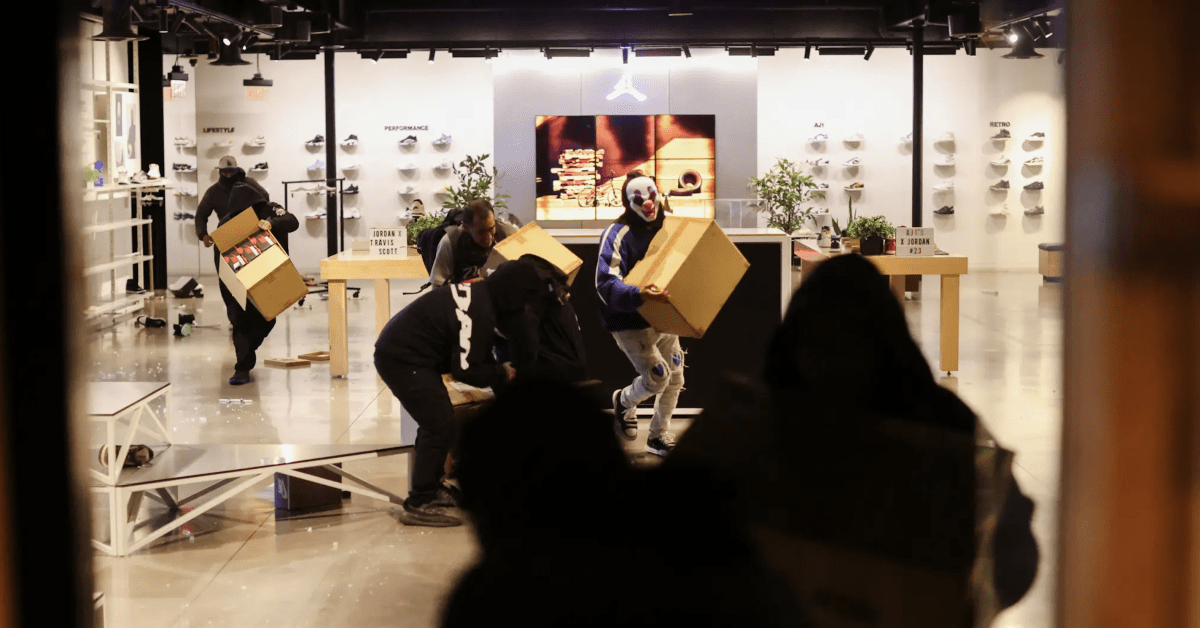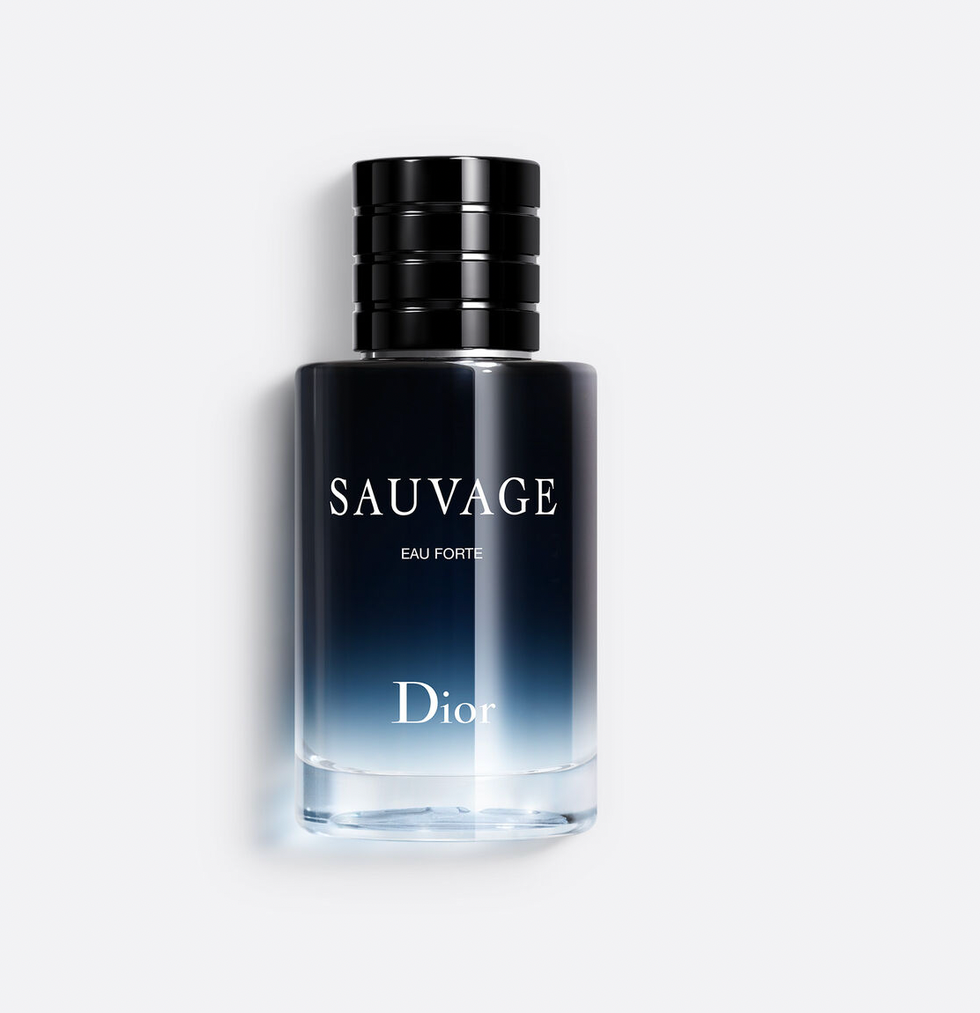The day before I sat down with Francis Kurkdjian, the perfume creation director for Dior, we were on a boat smack-dab in the middle of Lake Powell in Utah. It’s a trippy place, where canyons of dusty red rock rise out of cool, blue water. It’s hard to wrap your mind around it at first—especially when you realize it’s all man-made. “Someone just decided to close a door and make a lake,” said Kurkdjian. “It’s fascinating.”
There is perhaps no better metaphor for the new Dior Sauvage Eau Forte ($160, at dior.com), the first men’s fragrance Kurkdjian has created for the house since taking up his current position in 2021. But Sauvage Eau Forte is no ordinary cologne. Marking another first, it’s the first men’s designer fragrance to be made completely alcohol-free. Most colognes on the market contain around 70 to 90 percent alcohol, into which fragrance is infused. Eau Forte, on the other hand, is made with innovative technology that allows for a water-based carrier, completely removing the need for alcohol.
Inspired by the “wild” quality of water, particularly the water that’s found in the desert (the inspiration for the original Sauvage), Kurkdjian created Eau Forte to not only push Sauvage forward but also change our idea of what a fresh cologne can smell like. He took out the requisite citrus (in this case, bergamot) and instead relied on the qualities of the water itself to create a smooth, cool freshness unlike anything else found in the Sauvage family. Even the spices, which he did not change, smell different when mixed with water. They’re smoother and sultrier, and they slide across your nose like silk.
The Sauvage DNA is still there, but it’s been manipulated into something modern and surprising. To hear Kurkdjian tell it, that’s the challenge of creating perfumes for such a storied house as Dior—walking the line between reinvention and don’t-mess-with-it success. But he’s clearly up to the task. Perhaps no other perfumer in the world has such a deft hand and innovative flair, yet his respect for the past and what was created before him is clear. The day after our boat trip, I sat down with Kurkdjian to discuss the challenges of creating Sauvage Eau Forte, the future of fragrance, and why it’s important to look back if you want to move forward.
Esquire: This is your first men’s fragrance for Dior. Why make a new Sauvage and not a completely new pillar?
Francis Kurkdjian: Why add a new pillar? I think when you’re number one in the world, you have to keep going. It’s the same thing with singers. If you’re the number-one best-selling singer in the world, you don’t stop singing. You keep doing performances and you keep launching albums. Basically, perfume works the same.
When you get in the house of Dior as the house perfumer, your job is divided in two parts. The first one is to take care of the heritage of the brand. And by that, I mean everything that has been created before you is heritage. Even if it’s six months old, it’s heritage. You can say you will start from scratch, but you can’t really, because it’s not like fashion. With fashion, you can be a new designer and empty the store because your job is to feed the store. But as a perfumer, Sauvage is number one in the world, so I’m not going to take it out of the shelves and bring a new thing.
So first, you have to learn how to live with the past. The second mission is to create new things. Sauvage, being number one, has lots of competition, let’s be honest. It’s our mission to be innovative the same way we were innovative with launching Elixir, which was at the time the first Elixir perfume on the market. The idea is also to stay at the forefront of innovation, because I think that if a brand is not innovative, a brand dies.
How did you walk that line with Sauvage?
The story behind Sauvage is a multiple-layer story. The first one, to me, is a story about the lavender as a key flower. Lavender is the only male flower from a Western perspective. It is the only flower that is heavily used in the men’s perfume, and it is the most popular one. And I think one of the key reasons for the success of Sauvage is because lavender is a reference, the same way as a suit. If you think about formalwear, you wear a suit. So lavender has that key role [in] that it’s an iconic flower and helps you to create an iconic perfume.
When you look back on the existing portfolio, the eau de toilette, eau de parfum, and the perfume and Elixir, basically there is a gradation of lavender between freshness to sensuality in terms of intensity. The same way, you go from the cool side of lavender to the dark side of lavender. Elixir is already the darkest side possible, and I thought we were missing something. That gave me the idea to create the counterpart of Elixir by creating a very cool and intense perfume.
How does the water-based element factor in?
I think the best thing to show you how it works is to do the demonstration.
Kurkdjian hands me two testers, one with the existing water-based Eau Forte and one with the same formula in alcohol. The water version smells smooth and cool, with a more rounded freshness that bleeds into warm, robust spices and smooth lavender. In alcohol, the same notes are sharp, zingy, and tingle my nose with an almost astringent quality.
You can feel the difference between how water brings an extra mile of wetness and coolness. That is something that you can’t get with alcohol.
It’s completely different. In alcohol, I know that you didn’t use citrus, but it smells like you did.
Yes, because it’s sharper. You have a kick that is a bit almost metallic. And when you use water, it works almost like a watercolor. It blends the ingredients better.
You also said that the water blooms the spices differently.
Yes.
Sauvage is spicy, but this has a completely different spice profile to me. Did you use different spices?
No. I kept the same ones, but I just balanced the formula differently. And I removed the classic freshness from bergamot.
I feel like with men’s fragrance, freshness has a very specific connotation, and it’s cool that you rethought it.
To me [traditional freshness] smells very ’80s. Sauvage is a bit classic in that way, which is part of the success.
This morning I sprayed Sauvage on one wrist and Sauvage Eau Forte on the other. They’re both so different, but they’re also both still fresh.
Yes, that was the idea. To be different and to maintain the freshness.
When you create a water-based fragrance, do you approach it differently?
You do all trials in the finished formula, because the difference is too big.
Why is it milky looking?
To make it alcohol-free, we need to add a third party that basically creates the link between oil and water. Because oil and water don’t mix. It’s like with the vinaigrette. If you put oil and water, the water sits on top of the oil. So you have to add a third party, in this case a third ingredient that is unscented but basically creates the bridge within the oil and the water. And once you get that, you blend it in a blender. It’s a big tank, and you have two mixers to create an emulsion. You get the white because you need that ingredient. And when you mix it, this is how it gets in the emulsification process.
Do you feel all fragrance is heading in an alcohol-free direction?
It will go toward that if we get competition. It’s the same way we had competition with Elixir. When we launched Elixir as a new concentration in the masculine playground, Dior was the only one. Now you have many other brands that have taken over in a way, followed the path. So it will become a real market if we have followers, if we have competition. This is how the economy works. .
Is alcohol-free fragrance more sustainable?
The main reason is not sustainability. The main reason is about the galénique, the feeling of it, what it brings to the product. Of course, you can see that there is a sustainability side of the project, because to create alcohol, you need to grow plants that you distill. So the process is a bit different, but I would say that sustainability is not the main concern.
When I think of Sauvage, I think of the desert. But you were inspired by water. Is that the direction you see the Sauvage family heading?
But water can also be very Sauvage. Water can be very wild in a way, and wild in different aspects. The lake is one of them. Or you have the waterfalls that we have in the ad, which is another way. It’s true that for the past ten years, Sauvage was about the desert, but it rains in the desert. And the power of the rain in the desert is even more powerful, because what is rare is precious.
What is your vision for the future of fragrance in general?
I think the market will split with brands who would be able to afford the raw materials and some brands who won’t be able to. Because the way it’s going, natural ingredients will cost more and more because of the biodiversity being endangered—because of climate change—which is very important for natural ingredients. Sourcing is very important, and also the quantity. We have lots of land, but we also need to feed the planet. So at some point, we have to make a choice. Do we want to feed the planet, or do we want to make great perfumes? That is my concern.
What do you think the future of sustainability in fragrance looks like?
We’re going to go back to something from the 18th century. Back then, you have one bottle, you go back to your retailer, you refill it, and you take it home. This is what happened until the end of the 19th century because it was hard to create bottles.
Today it’s not hard; it’s costly. It costs the environment, it costs money, and it costs energy. But what is funny is the process is the same at the end. In the 18th century, there was a scarcity of material and scarcity of product, so perfume was very precious. Now this is very precious for another reason. We know how to do it, but we try not to do it because it costs the environment. So it’s very funny how two different things for two different reasons can lead to the same result.
So I would say the future looks more like the past in a way. Sometimes we should look back more often, I think.
Read the full article here












